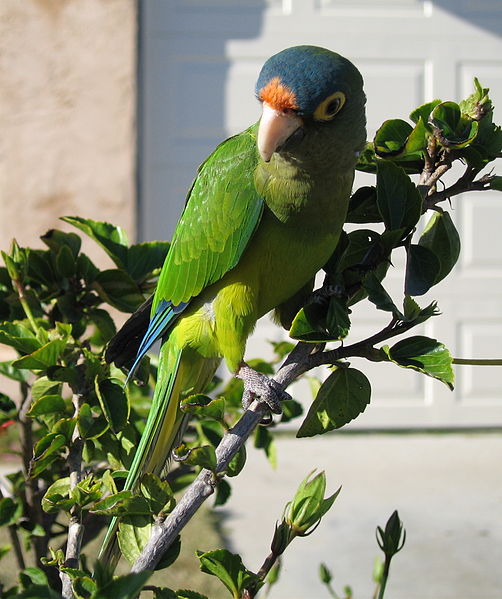 Last time we took a look at the unusual nesting behavior of this popular little parrot (please see The Half Moon, Orange-Fronted or Petz’s Conure and its Relationship with the Arboreal Black-Headed Termite.) But, as if breeding in termite mounds were not enough to distinguish it from other parrots, the half moon conure also changes the usual parrot “roosting rules” as well. And with good reason…
Last time we took a look at the unusual nesting behavior of this popular little parrot (please see The Half Moon, Orange-Fronted or Petz’s Conure and its Relationship with the Arboreal Black-Headed Termite.) But, as if breeding in termite mounds were not enough to distinguish it from other parrots, the half moon conure also changes the usual parrot “roosting rules” as well. And with good reason…
Giant Bats and Conures…Avoiding a Nightmarish Predator
The half moon conure exhibits a few odd behaviors as regards predator avoidance. Researchers in Guancastle, Costa Rica, have noted that resident half moon conures change roosting sites nightly. It seems that they are the favored prey of a truly unique predator, the huge false vampire bat, Vampyrum spectrum (I’d certainly move around allot if it helped to outwit a giant, flesh-eating bat!).
False vampires are spectacular and unusual bats. Although I have yet to see one in the wild, I was shown a roosting hollow in Costa Rica (they roost singly or in small groups, unlike most bats). The floor below the tree cavity in which the beast spent the day was littered with parrot feathers and the skulls of rodents, frogs and other bats.
A Quiet Group of Parrots?
Another unusual half moon trait is their habit of becoming very quiet upon first sighting a predator. The quiet – rather than, as with most parrots, the noise – spreads to adjacent groups of conures very quickly. If the predator advances, the conures begin to scream in true parrot fashion and fly off.
Further Reading
A false vampire bat may have been an incident involving a parrot that I came to know while working in Costa Rica. Please see my article Parrots and the Perils of the Tropical Night.
The following article contains a wealth of information on false vampire bats in the wild and captivity. Bats are not birds…but this one is well-worth reading about!
http://www.science.smith.edu/departments/Biology/VHAYSSEN/msi/pdf/i0076-3519-184-01-0001.pdf
Photo courtesy of Wikipedia Commons.
 That Bird Blog – Bird Care and History for Pet Birds
That Bird Blog – Bird Care and History for Pet Birds

 Clad in green plumage, with blue and orange crescents topping the head, the 9-inch-long half moon conure brings to mind a small, feisty Amazon parrot. These boisterous little birds breed well in captivity and, when acquired young, make delightful pets. Combined with a relatively low price, these qualities have rendered the half moon one of the most commonly-kept of the conures. Its breeding biology in the wild, however, is anything but common.
Clad in green plumage, with blue and orange crescents topping the head, the 9-inch-long half moon conure brings to mind a small, feisty Amazon parrot. These boisterous little birds breed well in captivity and, when acquired young, make delightful pets. Combined with a relatively low price, these qualities have rendered the half moon one of the most commonly-kept of the conures. Its breeding biology in the wild, however, is anything but common. Returning to the Cage
Returning to the Cage